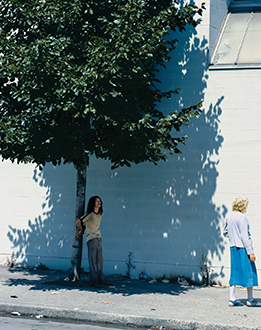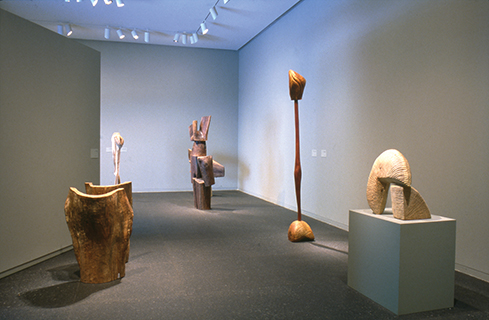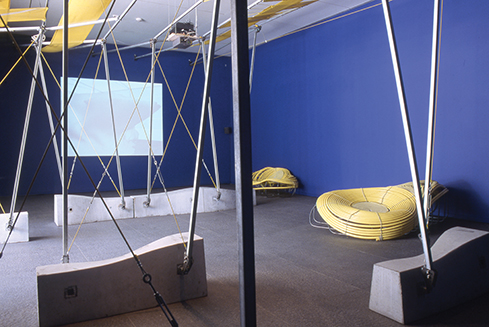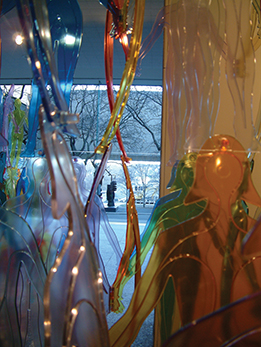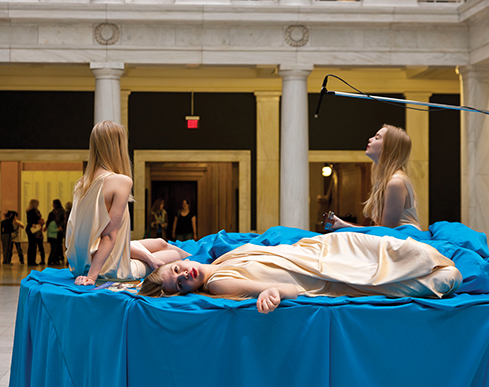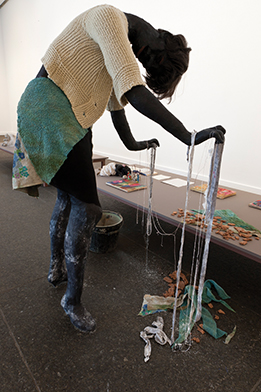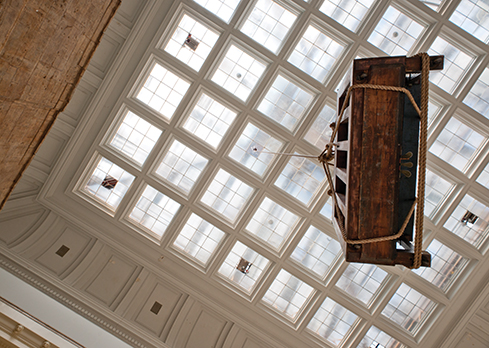 |
||||||||||||||||
Forum 74: Antoine CatalaPhoto: Bryan Conley |
Art of the Now
For the past 25 years, Carnegie Museum of Art’s Forum series has put up-and-coming contemporary artists front and center. On November 3, 1990, Carnegie Museum of Art debuted an ongoing exhibition series dedicated to contemporary art in all its many forms in a prominent space just inside the museum’s front entrance, renamed the Forum Gallery. The choice was bold but consistent for a museum that was arguably the first museum of contemporary art in the United States.
Curators looked for artists who were emerging or whom they felt were not as widely known as they should be. The museum featured work by conceptual photographer Jeff Wall, who today is recognized as one of the most inventive artists of his generation, in the series’ very first show, Forum 1. At the time, co-curators Clark and Mark Francis were interested in the expanded use of photography in art. Wall’s large, photographic transparencies mounted in lightboxes made reference to classic paintings and offered commentary on social issues of the day. The museum later purchased one of the luminous images, Trân Dúc Ván—a scene that provokes issues of class, race, and the disadvantaged— marking one of Wall’s first acquisitions by an American museum. Twenty-five years later, the Forum Gallery is hosting its 76th exhibition. While the landscape around contemporary art has changed, the Forum series remains a steady drumbeat for the Museum of Art to put its weight behind new ideas and to create a real conversation among artists, curators, and visitors. Of Its TimeContemporary art has always played a major role in the identity of Carnegie Museum of Art. A year after its founding in 1895, Andrew Carnegie launched the Carnegie International—the famed survey of international contemporary art—as a way for the museum to discover, exhibit, and acquire new works from modern masters. The contemporary program waxed and waned over the years, but starting in the 1980s, during the tenure of museum director Jack Lane and curator of contemporary art John Caldwell, “it really took off and became increasingly important for the museum,” says Lynn Zelevansky, The Henry J. Heinz II Director of Carnegie Museum of Art. It was then that the museum’s leadership renewed its interest in the International—going back to its original survey format after a decade-long departure that focused on single-artist retrospectives. Not coincidentally, the ’80s also saw an increased appetite for contemporary art among the American public. “People were not alienated or turned off by contemporary art,” says Mark Francis, the museum’s former curator of contemporary art and first director of The Andy Warhol Museum, who launched the Forum series. “That’s an attitude that really disappeared in the ’50s and ’60s. It’s extraordinary when you look back at it. It has a huge audience today, and I think that’s developed over the last 20 years or so.”
The presence of contemporary art in major museums was still nascent but beginning to boom. Major institutions, both catalyzing the public’s interest and responding to it, began hosting a new type of regular exhibition. Often branded with a single-word moniker, these series—Projects at the Museum of Modern Art in New York and MATRIX at the Wadsworth Atheneum Museum of Art in Hartford—consisted of small shows often focusing on just a single artist. By limiting their scope, curators could be timely and responsive to a genre that was constantly reinventing itself. While contemporary art already had a home at Carnegie Museum of Art, the International was exhaustive, time-intensive, and it only happened every few years. “It’s not surprising that we would have realized that we needed this kind of program,” says Zelevansky. “As a program that is described numerically and sequentially, you can look back and see a really interesting snapshot and evolving picture of contemporary art at the museum.”
- Eric Crosby, The Richard Armstrong Curator of Modern and Contemporary ArtSo in the fall of 1990, with funding from the National Endowment for the Arts, the museum launched the Forum series. A title “with the suggestion of a space and a dialogue—it is designed to be flexible, timely and vital,” according to its original description.
“The idea was to make sure that we had an exhibition of contemporary art up at all times,” says Clark. “That way, the International wouldn’t just hit you in the face every three years,” adds Francis, now director of the Gagosian Gallery in London. “There was ongoing context, and I think that’s very important.” Today's TastemakersOf the museum’s five departments, four of them do work that concentrates partly or fully on the contemporary—decorative arts and design, contemporary art, photography, and the Heinz Architectural Center. A principle of Forum is that it can feature shows curated by any of them. “That was very important at the beginning—that anybody on the staff could do it. Because contemporary art meant any medium and any kind of art being made,” says Clark.Among Forum’s highlights: the earthy, fluid sculptures of renowned Pittsburgh artist Thaddeus Mosley; the forest of aluminum lacework and steel chains by legendary British structural engineer Cecil Balmond; and, just recently, the intricate wooden cabinets of designer Sebastian Errazuriz that unfold into explosive shapes more closely resembling sculpture than furniture.
“It’s like a journalist or editorial writer having a weekly column,” says Dan Byers, the museum’s former curator of contemporary art now at Boston’s Institute of Contemporary Art. “Over time that consistent voice begins to form a kind of character for the museum.” The Forum Gallery has played host to work by artists ranging from Pittsburgh-based Ed Eberle and Diane Samuels to Japanese appropriation artist Yasumasa Morimura and Ann Hamilton, the recent winner of the National Medal of Arts. Many of the artists have visited the museum and given well-attended talks. “As a program that is described numerically and sequentially, you can look back and see a really interesting snapshot and evolving picture of contemporary art at the museum,” says Eric Crosby, who joined the Museum of Art this fall as its Richard Armstrong Curator of Modern and Contemporary Art. He came to the museum from the Walker Art Center in Minneapolis, where he worked on similarly structured single-artist exhibitions and developed his interest in film and video. Compared to the three years it often takes curators to assemble a large-scale museum exhibition, Forum shows can be curated in a year, sometimes less.
In July 1999, Forum 40 opened before Spanish artist Felix de la Concha had even finished making the art. De la Concha had already shown his work in Europe and at the Columbus Museum of Art in Ohio. He moved from Columbus to Pittsburgh the previous fall with his girlfriend, who was studying at the University of Pittsburgh, and almost immediately began a project to create a painting of the Cathedral of Learning every day for a year, each time from a new perspective. “It's like a journalist or editorial writer having a weekly column. Over time that consistent voice begins to form a kind of character for the museum.”
- Dan Byers, the former Richard Armstrong Curator of Modern and Contemporary Art“It became something very existential about representing this moment that is not going to be happening again,” says de la Concha. His practice, too, became about seizing the moment. A realist painter, he had about two hours to capture as much detail as he could before the lighting changed. Francis, who visited de la Concha’s studio when he was about three months into the project, recognized a connection to the work of Japanese conceptual painter On Kawara, who had recently won the Carnegie Prize, the honor awarded to the top artist at each Carnegie International, for his “date paintings.” Each painting included a date and an often painted-over front page of the local newspaper from the city where Kawara happened to be that day. Both artists explored the passage of time through painting, Francis noted, which is why he recommended de la Concha to the incoming curator of contemporary art, Madeleine Grynsztejn. His work wrapped the walls of the Forum Gallery about six months later. The project was among the series’ most popular. “They told me they had beat records for visitors at the Forum Gallery,” says de la Concha. He completed the last 50 canvases while the show was already public, prompting visitors to return to see the work evolve. The final project, titled One a Day: 365 Views of the Cathedral of Learning, was acquired by the University of Pittsburgh and now hangs on permanent view in its Alumni Hall. New SurprisesAmong the most talked about Forum artists in recent memory is Icelandic musician and performance artist Ragnar Kjartansson. In 2011, Forum 66 was curated by Byers and premiered the new work Song, which the artist created specifically to be performed in the museum’s regal Hall of Sculpture. Inspired by an Allen Ginsberg poem, the work featured Kjartansson’s three adult nieces—dressed in white and draped over royal blue satin sheets— performing live, singing in three-part harmony, “The weight of the world/is love,” over and over again, for three weeks straight.
“Something’s happening when you overhear the baristas at Starbucks talking about a show, and when I get stopped and asked about it in the grocery store,” said Byers at the time. “I like the idea that the program can force surprises as it rotates,” Crosby says. “Considering 25 years of Forum is a good opportunity to reflect and think about possibilities for the future,” noting that he didn’t arrive at the museum armed with a shortlist of artists he wants to work with. “I have to develop a familiarity with the museum, its people, its collection, its context, and its audience to see what kind of ideas really emerge there,” he says. “But I do think it’s important to emphasize the free-form identity of the series. It shouldn’t be beholden to what’s come before.” Today, Forum exhibitions are striving to be more responsive to the needs of the art they present, says Zelevansky, not necessarily limiting it to its traditional space in the museum’s lobby. Forum 67 by Cathy Wilkes, for example, featured haunting sculptures set among quiet domestic scenes. “Cathy’s work is so intimate, when we later installed it in the permanent collection galleries, I felt it was happier there,” says Zelevansky.
Ultimately, whether Forum is “a space or an idea,” as Zelevansky puts it, curators agree that the value of the series and the reasons it continues remain remarkably unchanged. “Despite the exponential growth of the contemporary art market and the proliferation of galleries internationally, artists still need both the endorsement and the opportunities that museum exhibitions bring,” says Zelevansky. “Since [its] inception, we have seen a rapid broadening of interest among museumgoers in the art of our time—from those who are knowledgeable and follow it critically to those who are curious and looking for something new,” adds Crosby. “As that interest and audience have grown, so, too, has the responsibility of the museum to continue to present new work by living artists.” The current contemporary surprise greeting visitors to Carnegie Museum of Art: Forum 76, The Living Need Light, The Dead Need Music, part documentary and part visionary reenactment by artist collective The Propeller Group. Support for the Forum series is generously provided by the Juliet Lea Hillman Simonds Foundation.
|
|||||||||||||||
The Elevation of Everyday Design · Taking its Bow · Inside the Cloud Factory · President's Note · NewsWorthy · About Town: Changing the Conversation · Artistic License: In Full Light · Travel Log · The Big Picture
 |
Copyright © 2017 CARNEGIE Magazine. All rights reserved. |

